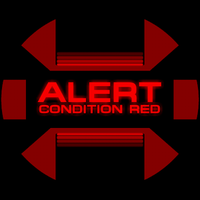No edit summary |
No edit summary |
||
| Line 5: | Line 5: | ||
There are three standard conditions named after colors - these also correspond to the color of alert notification lights throughout a location. | There are three standard conditions named after colors - these also correspond to the color of alert notification lights throughout a location. | ||
* Condition Red / Red Alert corresponds to ''Condition 1'' | * Condition Red / Red Alert corresponds to ''Condition 1'' | ||
* Condition Blue / Temporal Alert corresponds to ''Condition 2'' | |||
* Condition Yellow / Yellow Alert corresponds to ''Condition 3'' | * Condition Yellow / Yellow Alert corresponds to ''Condition 3'' | ||
* Condition Green / Normal Operations corresponds to ''Condition 0'' | * Condition Green / Normal Operations corresponds to ''Condition 0'' | ||
| Line 37: | Line 38: | ||
|- | |- | ||
|2 | |2 | ||
|style="white-space: nowrap;"|Temporal Alert | |style="white-space: nowrap;"|Temporal Alert<br>Condition Blue | ||
| | | | ||
* [[TDE]] / [[Dimensional Fold Drive]] brought online at ready status. | * [[TDE]] / [[Dimensional Fold Drive]] brought online at ready status. | ||
Revision as of 06:39, 22 December 2016

Alert condition codes allow for standard procedures to be followed in specific conditions.
Colored Conditions
There are three standard conditions named after colors - these also correspond to the color of alert notification lights throughout a location.
- Condition Red / Red Alert corresponds to Condition 1
- Condition Blue / Temporal Alert corresponds to Condition 2
- Condition Yellow / Yellow Alert corresponds to Condition 3
- Condition Green / Normal Operations corresponds to Condition 0
- Grey Mode corresponds to Condition 7
Numbered Conditions
| Number | Name | Description |
|---|---|---|
| 0 | Condition Green |
|
| 1 | Tactical Alert Red Alert General Quarters Battle Stations |
|
| 2 | Temporal Alert Condition Blue |
|
| 3 | Yellow Alert |
|
| 4 | Environmental Alert |
|
| 5 | Decompression Alert Collision Alert |
|
| 6 | Security Alert |
|
| 7 | Grey Mode |
|